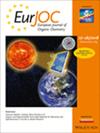探索拓扑变化对六苯类化合物底单重态和最低三重态稳定性的影响
IF 2.5
3区 化学
Q2 CHEMISTRY, ORGANIC
引用次数: 0
摘要
多环芳烃(PAH),如四烯、五烯、六烯和一些更高的烯类,由于其独特的电子性质,在有机电子学中起着核心作用。拓扑变化对不同电子态的多环芳烃异构体相对稳定性的影响了解甚少,对Clar p-六元体和海湾、海湾、峡湾和k区等拓扑特征如何影响其基态单线态(S0)和最低三重态(T1)稳定性的了解有限。在这项工作中,我们执行密度泛函理论计算了37个浓缩六苯类化合物的S0和T1态。采用以相对能量为因变量,以一系列拓扑参数为自变量的多元线性回归模型,量化了拓扑对六苯类化合物相对稳定性的影响。我们的分析表明,在50中,Clar p-六分体和k区数量的增加增强了稳定性,而海湾和峡湾的存在则降低了稳定性。在T1中,主要的稳定因子是Clar p-六聚体的数量和反芳香区所涉及的环的数量,而k边、海湾、海湾或峡湾等拓扑区域则是不稳定的。本文章由计算机程序翻译,如有差异,请以英文原文为准。
Exploring the Impact of Topological Variations on the Stability of the Ground Singlet and Lowest-Lying Triplet States of Catacondensed Hexabenzenoids
Polycyclic aromatic hydrocarbons (PAH) like tetracenes, pentacenes, hexacenes, and some higher acenes play a central role in organic electronics due to their unique electronic properties. The impact of topological variations on the relative stability of PAH isomers in different electronic states is poorly understood, with limited insights into how Clar p-sextets and topological features like bay, cove, fjord, and K-regions influence stability in their ground singlet (S0) and lowest-lying triplet (T1) states. In this work, we perform density functional theory calculations of the S0 and T1 states of the 37 catacondensed hexabenzenoids. We use a multivariate linear regression model with relative energy as the dependent variable and a series of topological parameters as the independent variables to quantify the effect of topology in the relative stability of the catacondensed hexabenzenoids. Our analysis shows that, in S0, stability is enhanced by an increase in the number of Clar p-sextets and K-regions and decreased by the presence of coves and fjords. In T1, the main stabilizing factors are the number of Clar p-sextets and the number of rings involved in the antiaromatic region, whereas topological regions like K-edges, bays, coves, or fjords are destabilizing.
求助全文
通过发布文献求助,成功后即可免费获取论文全文。
去求助
来源期刊
CiteScore
5.40
自引率
3.60%
发文量
752
审稿时长
1 months
期刊介绍:
The European Journal of Organic Chemistry (2019 ISI Impact Factor 2.889) publishes Full Papers, Communications, and Minireviews from the entire spectrum of synthetic organic, bioorganic and physical-organic chemistry. It is published on behalf of Chemistry Europe, an association of 16 European chemical societies.
The following journals have been merged to form two leading journals, the European Journal of Organic Chemistry and the European Journal of Inorganic Chemistry:
Liebigs Annalen
Bulletin des Sociétés Chimiques Belges
Bulletin de la Société Chimique de France
Gazzetta Chimica Italiana
Recueil des Travaux Chimiques des Pays-Bas
Anales de Química
Chimika Chronika
Revista Portuguesa de Química
ACH—Models in Chemistry
Polish Journal of Chemistry.

 求助内容:
求助内容: 应助结果提醒方式:
应助结果提醒方式:


